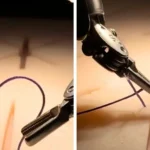Key Points
- TU Wien’s researchers discovered that silver nanoparticles on carbon are 200 times more active than pure silver.
- The activity boost occurs at the boundary where silver particles directly contact carbon atoms. Less precious metal is needed for the same catalytic effect.
- A hydrogen isotope exchange method was developed to test carbon carriers’ catalytic effectiveness. The findings enable quick evaluation of carbon sources.
- This research could lead to new, efficient catalytic applications, optimizing resources in chemical manufacturing.
Researchers at TU Wien (Vienna) have made a breakthrough in understanding why metal nanoparticles, like silver, exhibit significantly enhanced catalytic activity when placed on carbon substrates. The research team discovered that silver atoms on carbon are 200 times more active than those on pure silver, shedding light on a phenomenon that had puzzled scientists for years. Published in ACS Catalysis, this discovery provides deeper insight into catalysis at the atomic level and opens the door for more efficient and cost-effective industrial processes.
Precious metals such as platinum, palladium, and silver are widely used as catalysts in the chemical industry to speed up reactions that would otherwise proceed very slowly or not at all. These metals are typically used in nanoparticle form, and their catalytic effectiveness depends heavily on the substrate. Carbon substrates, in particular, appear to enhance catalytic activity, but until now, the reason for this has been a mystery.
Through advanced precision measurements and computer simulations, the TU Wien team examined silver nanoparticles on carbon substrates and compared them to pure silver in a controlled microreactor environment. They could accurately measure catalyst activity by introducing a hydrogen isotope exchange method. This technique, involving the splitting and recombination of hydrogen molecules, showed that silver atoms on carbon outperformed those on pure silver by a factor of 200, highlighting a remarkable increase in efficiency.
The team’s findings indicate that the effect arises precisely at the boundary where the silver particles contact the carbon substrate. In this “interface” region, both a carbon atom and a silver atom interact directly with the reactant molecule. Contrary to previous assumptions, the catalyst’s enhanced performance does not depend on the carbon’s size, foreign atoms, or surface functional groups. Rather, the activity is strongest where carbon and silver meet directly.
This understanding could revolutionize industrial catalytic processes. Since only a fraction of precious metal is needed to achieve the same results, this discovery can reduce costs substantially. Additionally, the hydrogen isotope exchange test can now serve as a rapid, reliable method for evaluating the effectiveness of different carbon sources, improving quality control, and reducing costs in industrial applications.












